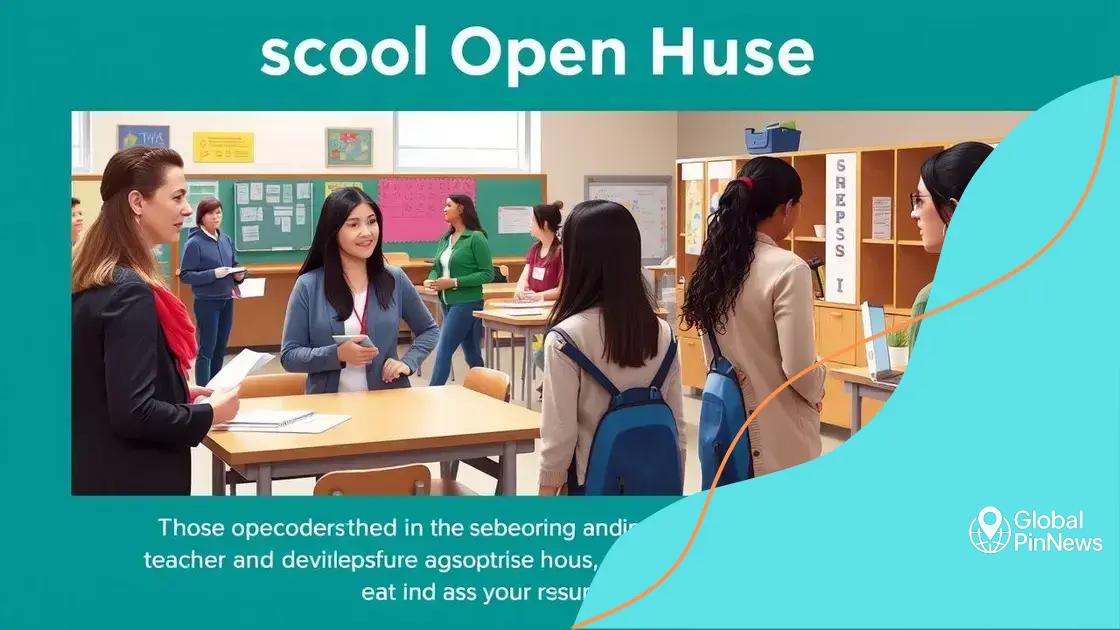Mid-year challenges in teacher recruitment you should know

Mid-year challenges in teacher recruitment result from increased competition, heavy workloads, and inadequate administrative support, significantly impacting the ability of schools to attract and retain qualified educators.
Mid-year challenges in teacher recruitment are becoming increasingly evident as schools struggle to fill essential positions. Have you noticed how this affects our education system? Let’s delve deeper into what’s happening.
Understanding current teacher shortages
Understanding the current teacher shortages is crucial for addressing the challenges we face in education today. Many factors contribute to this issue, impacting schools and students alike.
Key Factors Leading to Teacher Shortages
Several elements play a significant role in the ongoing teacher shortages. Notably, the demand for qualified educators is outpacing supply. This gap creates numerous challenges for schools striving to maintain quality education.
- Low salaries and benefits
- Increased workload and stress
- Retirement of experienced teachers
- Limited pathways for teacher certification
These factors are interlinked and create a cycle that can be difficult to break. Low salaries often deter potential candidates from pursuing a teaching career. Moreover, many teachers face overwhelming workloads, contributing to early burnout and exits from the profession. With the retirement of seasoned educators, the void becomes even more pronounced.
Impact on Schools and Students
The shortage of teachers significantly affects the educational landscape. Schools must often rely on substitutes or fill positions with less experienced individuals. This can lead to a decrease in the quality of education that students receive.
Additionally, the lack of qualified educators can result in larger class sizes, making it challenging for teachers to provide individualized attention. Students may feel less supported, which can impact their overall academic performance and emotional well-being.
Addressing this shortage requires a comprehensive approach, focusing on making teaching a more attractive profession. Providing better support, competitive salaries, and job satisfaction is essential for retaining current teachers and attracting new ones.
Reasons behind mid-year recruitment challenges
Understanding the reasons behind mid-year recruitment challenges can help schools tackle these issues head-on. As the academic year progresses, various factors contribute to the difficulties in hiring teachers.
Key Reasons for Recruitment Challenges
Mid-year recruitment comes with unique hurdles that make finding and retaining talent more complicated. One significant reason is the general perception of teaching as a high-stress profession. Many potential candidates may be deterred by the challenges associated with entering the teaching field late in the school year.
- Increased competition for qualified teachers
- Heavy workloads with limited support
- Short-term contracts or temporary positions
- Seasonal burnout affecting existing staff
The job market for educators is also quite competitive. Schools often struggle to attract sufficient applicants, as many qualified teachers may have already secured positions elsewhere. The nature of teaching roles during mid-year means potential hires may be faced with heavy workloads and limited support from their peers, which can further complicate their decision to join a particular school.
Impact of Administrative Decisions
Decisions made by school administrations can significantly affect recruitment. When schools are unable to offer favorable contracts or benefits, it becomes increasingly challenging to entice new hires. In addition, many teachers prefer to remain in stable positions rather than risk a mid-year transition that can impact their students.
Another issue is that teachers who are already in the profession may experience burnout, especially if they feel unsupported. This situation leads to higher turnover rates, compounding the recruitment challenges for schools. The need for solutions that address these fundamental issues cannot be overstated.
Strategies to attract teachers midway through the year

Implementing effective strategies to attract teachers midway through the year is essential for schools facing recruitment challenges. As the academic year progresses, schools can take proactive steps to bring in qualified educators and improve their hiring processes.
Creating a Positive Work Environment
A supportive and welcoming atmosphere can make a significant difference in attracting new teachers. Schools that foster a strong sense of community and collaboration often find it easier to entice candidates.
- Encourage teamwork among staff.
- Provide mentorship for new teachers.
- Promote a healthy work-life balance.
- Recognize and reward teacher achievements.
By highlighting these aspects, schools can present themselves as desirable workplaces, which can be a key factor in recruitment efforts.
Leveraging Technology for Outreach
Using technology effectively can enhance recruitment efforts. Social media platforms, job boards, and school websites can help spread the word about open positions. Schools can also utilize virtual job fairs to connect with potential candidates.
When advertising positions, it is crucial to be transparent about the roles and responsibilities. Clear communication helps set expectations for candidates. Additionally, offering flexible schedules or part-time positions may attract those who might not consider a full-time role.
Engaging with local colleges and universities can also provide a pipeline of recent graduates eager to enter the teaching profession. Partnering for internships or student-teacher placements can create stronger connections between experienced educators and new recruits.
Focusing on professional development opportunities is another valuable strategy. Schools that invest in their teachers’ growth and learning often appeal to potential hires looking for long-term career advancement.
Impact of teacher shortages on student performance
The impact of teacher shortages on student performance is significant and multifaceted. When schools struggle to find and retain qualified educators, students often bear the consequences. These shortages can create an environment where learning is compromised.
Effects on Classroom Dynamics
Classroom dynamics can shift drastically when there are not enough teachers. Larger class sizes often result from shortages, making it difficult for teachers to provide individualized attention. When teachers are overwhelmed, students may feel less supported and less engaged in their learning.
- Reduced one-on-one interaction.
- Increased behavioral issues.
- Less opportunity for differentiated instruction.
- Higher levels of student stress.
Moreover, when students do not receive the necessary support, their academic performance can decline. Students may struggle to grasp key concepts, leading to gaps in their knowledge.
Long-Term Consequences
The repercussions of teacher shortages extend beyond immediate academic outcomes. Students who experience inconsistent teaching or inadequate instruction may develop negative attitudes toward education. This can lead to lower graduation rates and reduced college readiness.
Additionally, a constant turnover of teachers can hinder the development of strong relationships between students and educators. When students lack trusted mentors, it can affect their motivation and overall school experience.
Ultimately, addressing teacher shortages is crucial not only for the educators but also for ensuring that students receive a quality education. Focused efforts on recruitment and retention can help create a stable learning environment, positively influencing student outcomes.
Best practices for schools to retain teachers
Implementing the best practices for schools to retain teachers is essential for maintaining a stable and effective educational environment. Retaining talented educators not only benefits the teachers themselves but also positively impacts students’ learning experiences.
Creating a Supportive Culture
A strong, supportive school culture is crucial for retention. When teachers feel valued and appreciated, they are more likely to stay. Schools can foster this environment by promoting collaboration and open communication among staff. Regular team meetings and professional development opportunities can enhance this supportive atmosphere.
- Encourage peer mentoring and coaching.
- Provide opportunities for teacher leadership roles.
- Recognize and celebrate teacher successes.
- Ensure adequate administrative support.
These practices help build a sense of community within the school. When teachers know that their contributions are recognized, it increases their job satisfaction.
Investing in Professional Development
Another vital aspect of retaining teachers is investing in their professional growth. Schools should offer ongoing training and development programs that address teachers’ needs and interests. This investment helps teachers improve their skills and feel more competent in their roles.
By aligning professional development with their career goals, schools can demonstrate that they care about their teachers’ future. Opportunities such as workshops, conferences, and advanced degree programs can be highly motivating. Schools can also encourage teachers to pursue innovative teaching methods that enrich their classroom experiences.
Moreover, providing competitive salaries and benefits is fundamental. When teachers feel they are compensated fairly for their work, they are more likely to commit to a school long-term. Transparent salary scales and opportunities for salary increases based on performance can further enhance retention efforts.
FAQ – Questions about Teacher Retention Strategies
Why is a supportive school culture important for teacher retention?
A supportive school culture fosters teamwork and open communication, making teachers feel valued and appreciated, which encourages them to stay.
How does professional development impact teacher retention?
Investing in professional development helps teachers grow their skills and feel competent, leading to higher job satisfaction and retention.
What role do competitive salaries play in retaining teachers?
Competitive salaries ensure that teachers feel they are compensated fairly for their work, which can significantly reduce turnover rates.
How can schools recognize and celebrate teachers’ achievements?
Schools can celebrate achievements through awards, shout-outs in meetings, or featuring accomplishments in newsletters, boosting morale and retention.
